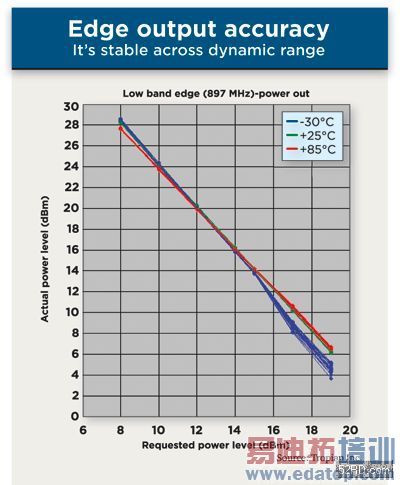- 易迪拓培训,专注于微波、射频、天线设计工程师的培养
Direct polar modulation has the right stuff
Driven by the need for improved efficiency and support for multiple complex standards, polar modulation solutions for cellular radios are emerging as the de facto standard modulation technique in the GSM/Edge market. Polar techniques provide superior power efficiency and are particularly suited to Edge. They were also applied to wideband CDMA standards in 2001 and to orthogonal frequency-division multiplexing (OFDM) in 2003.
Three major polar variants exist today: small signal/polar lite, polar loop and direct (open-loop) polar. While each method offers an advantage over traditional linear implementations, only direct polar is recognized as achieving the ultimate goals of simplicity and efficiency while maintaining RF spectral performance. This architecture also supports multiple modulation schemes using one common transmit path, thus enabling compact and cost-effective multimode handsets.

Direct polar is not without its industry skeptics, and current discussions are reminiscent of early criticism of the direct-conversion receiver architectures that now dominate the industry. Critics of the direct polar approach focus on power amplifier (PA) dependencies in high-volume production and on system characterization and programming complexity. While these concerns are not without merit, I contend they have been successfully addressed.
In the polar-lite architecture, PA issues are avoided by using a traditional linear PA to amplify the signal. But the downside is additional complexity and cost, as well as poor efficiency with the high peak-to-average ratio of new signals.
Polar loop uses feedback techniques to resolve the PA issues of stability over manufacturing, temperature and voltage. While this does help with stability, the RF feedback requires a separate precision receiver within the transmitter, often doubling the size of the chip and limiting the ability to support wideband signals.
To succeed with direct polar, one must discard the notion that the PA must be a precision linear device. By suppressing circuit linearity and operating the PA as a switch, the PA circuitry enters an extremely stable and predictable operating mode. When designed properly, such a PA readily suppresses output drift, and its efficiency is extremely high.
This approach is key to understanding how it is possible to reduce the complexity of PA characterization and calibration so that those tasks become become manageable and repeatable. As the diagram shows, uncompensated power stability is readily achieved across the required dynamic range and across manufacturing variations and temperature extremes.
For handset designers, this approach reduces the amount of design calibration required. Once correctly designed and calibrated, a particular PA will behave in a very stable fashion from handset to handset. With direct control of the PA, it’s also possible to eliminate the need to compensate for battery voltage and temperature; there are no stability issues under mismatch; and power ramp and transient control problems are eliminated.
It’s time for a shift in approach to radio design to meet modern requirements. The ability of this architecture to address market needs will speed its adoption.
By Earl W. McCune Jr. (earl.mccune@tropian.com), founder and chief technology officer at Tropian Inc. (Cupertino, Calif.)
上一篇:Advances in radio technology may be significant
下一篇:Create a flexible EDGE data receiver(Part 1)

